Xerocomus Quél.
Recent molecular studies have shown that Xerocomus in its current circumscription is likely an artificial grouping and it is possible that it will be split at some point into smaller genera. Molecular studies also have changed our understanding about the species of xerocomoid boletes showing that morphological features are quite variable in this group. Not only microscopic study is essential for determination, but scanning electron microscope will be often needed in this “genus” as the spore ornamentation is not always seen under ordinary light microscope. Do bear in mind that macroscopic characters, such as colours, cracking cuticle, etc., tend to intergrade between the different species. Note that Boletus impolitus and Boletus depilatus that were shown to be close to Xerocomus subtomentosus and its allies, are here retained in Boletus for practical reasons. The same applies also for Phylloporus pelletieri, placed here in a genus of its own, but being also close to Xerocomus subtomentosus group.
Although large reference list will be found under most of the species, one should always consult Ladurner & Simonini (2003) having in mind that there are some new species (X. chrysonemus, X. marekii, X. silwoodensis) described after this otherwise superior book was printed. Useful keys, covering most of the European xerocomoid boletes (except some southern taxa) are provided by Knudsen & Vesterholt (2008), Hills (2008) and Kibby (2011), the later also featuring an excellent comparison chart.
Fruitbody medium to small sized, boletoid, without veil and ring. Stipe solid, often tapering towards the base. Flesh variously coloured, changing or not when exposed to air. Tubes not separable from each other, instead tearing apart. Pores usually angular.
Xerocomus rubellus (Krombh.) Quél.
Description
Cap up to 5 cm, at first hemispherical, later convex to flattened, bright red, carmine, dark red, reddish brown, often with age discolouring to apricot, ochraceous with reddish tint, sometimes to entirely ochraceous, dry, velvety, often cracked. Stipe cylindrical, ventricose or club-shaped, yellowish and usually covered throughout with very fine red granules, often discolouring with age, blueing when bruised. Tubes pale yellow to yellow with olivaceous tint, blueing when injured. Pores concolorous with the tubes, blueing when bruised. Flesh whitish to yellowish in the cap, yellow in the stipe, with numerous orange, orange red or red dots in the stipe base, blueing when exposed to air. Smell not distinctive. Taste not distinctive. Spores 11–15 × 4.5–6.5 μm, smooth. Pileipellis palisadoderm of septate hyphae of cylindrical, incrusted cells.
Habitat. Broadleaf or mixed woodlands, urban areas, mycorrhizal with oaks (Quercus) or lime (Tilia).
Distribution. In Europe widespread.
Similarity. Most similar to Xerocomus communis with which it shares the presence of red dots in the flesh in the stipe base. The cap of Xerocomus communis is usually coloured ochraceous or light to dark brown. Discoloured specimens of X. rubellus strongly resemble X. communis and the distinction is almost impossible.
A number of other red caped boletes resemble X. rubellus. None of them has red dots in the flesh in the stipe base. These are:
Xerocomus cisalpinus – distinguished also by its striate spores
Xerocomus dryophilus – distinguished by the beetroot red flesh in the lower parts of the stipe
Xerocomus fennicus – distinguished by its truncate and striate spores
Xerocomus marekii – distinguished by its truncate spores
Xerocomus ripariellus – distinguished by its striate spores
Photographs

Typical, bright red coloured fruitbodies of Xerocomus rubellus. (photo I. Uhanova)

Typical fruitbodies of Xerocomus rubellus. (photo G. Kibby)
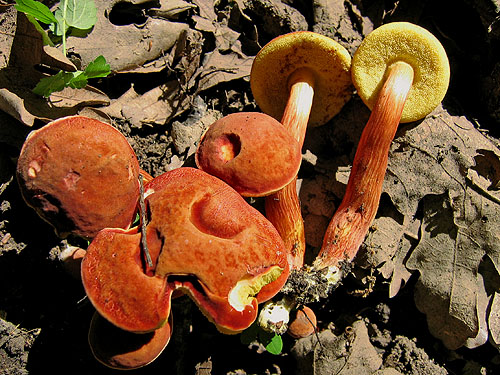
Xerocomus rubellus - typically coloured fruitbodies. (photo B. Assyov)
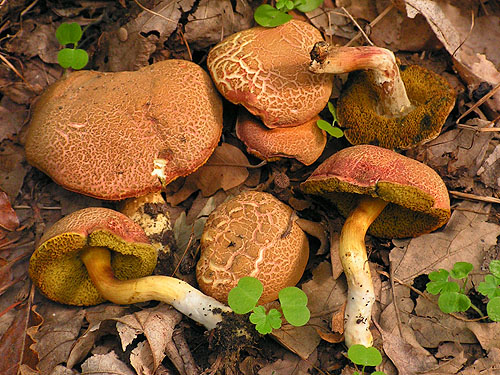
Rich collection of slightly discollored fruitbodies of Xerocomus rubellus. (photo B. Assyov)
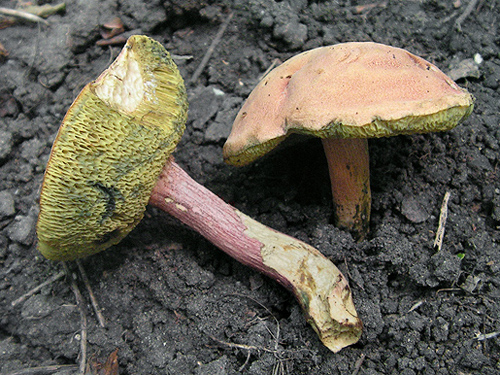
Discoloured fruitbodies of Xerocomus rubellus, slightly resembling Xerocomus armeniacus. (photo I. Assyova)
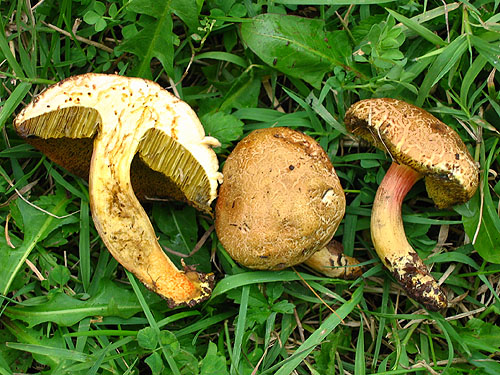
Strongly discoloured fruitbodies of Xerocomus rubellus. (photo B. Assyov)
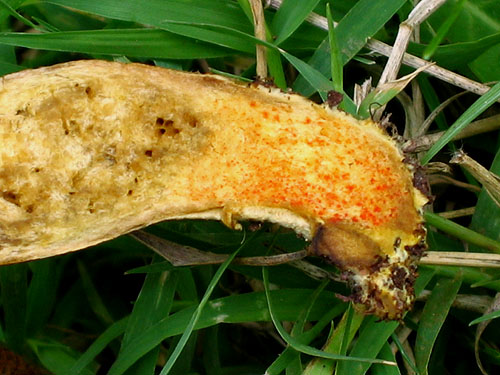
Detail of the flesh in the stipe base of Xerocomus rubellus. The red dots are notable feature of this species. (photo B. Assyov)
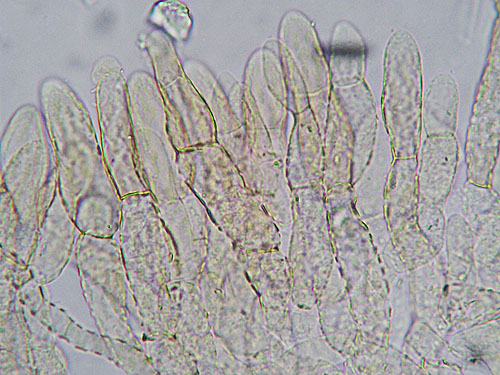
Detail of the cap cuticle of Xerocomus rubellus - a palisadoderm of heavily incrusted hyphae. (photo B. Assyov)
Important literature
Alessio, C.L. 1985. Boletus Dill. ex L. (sensu lato). – In: Fungi Europaei. Vol. 2. Pp. 1–705. Libreria editrice Biella Giovanna, Saronno.
Engel, H., Dermek, A., Klofac, W., Ludwig, E. & Brückner, T. 1996. Schmier – und Filzröhrlinge s. l. in Europa. Die Gattungen Boletellus, Boletinus, Phylloporus, Suillus, Xerocomus. Verlag Heinz Engel, Weidhausen b. Coburg.
Estadès, A. & Lannoy, G. 2004. Les bolets européens. – Bulletin Mycologique et Botanique Dauphiné-Savoie 44(3): 3–79.
Galli, R. 1998. I Boleti. Atlante pratico-monographico per la determinazione dei boleti. Edinatura, Milano.
Hills, A.E. 2008. The genus Xerocomus. A personal view, with a key to the British species. Field Mycology 9(3): 77–96.
Knudsen, H. & Vesterholt, J. [eds.]. 2008. Funga Nordica. Nordsvamp, Kopenhagen.
Ladurner, H. & Simonini, G. 2003. Xerocomus s.l. – In: Fungi Europaei. Vol. 8. Pp. 1–527. Edizioni Candusso, Alassio.
Lannoy, G. & Estadès, A. 2001. Les Bolets. Flore mycologique d’Europe. Documents Mycologiques Mémoire Hors série no. 6. Pp. 1–163. Association d’Écologie et de Mycologie, Lille.
Oolbekkink G.T. 1991. The taxonomic value of the ornamentation of spores in ‘the Xerocomus-group’ of Boletus. – Persoonia 14: 245–273.
Simonini, G. 1998. Xerocomus chrysenteron e X. rubellus: delimitazione e casi di simulazione. – Micologia e Vegetazione Mediterranea 13: 69–89.
Šutara, J., Mikšík, M. & Janda, V. 2009. Hřibovité houby. Čeled’ Boletaceae a rody Gyrodon, Gyroporus, Boletinus a Suillus. Academia, Praha.
Watling, R. & Hills, A.E. 2005. Boletes and their allies (revised and enlarged edition). – In: Henderson, D.M., Orton, P.D. & Watling, R. [eds]. British Fungus Flora. Agarics and boleti. Vol. 1. Royal Botanic Garden, Edinburgh.